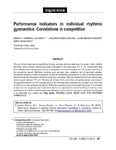Performance indicators in individual rhythmic gymnastics: Correlations in competition

Use this link to cite
http://hdl.handle.net/2183/37095
Except where otherwise noted, this item's license is described as Atribución-NoComercial-SinDerivadas 3.0 España
Collections
- Investigación (CCDEF) [297]
Metadata
Show full item recordTitle
Performance indicators in individual rhythmic gymnastics: Correlations in competitionAuthor(s)
Date
2018Citation
Fernández-Villarino, M.A., Hernaiz-Sánchez, A., Sierra-Palmeiro, E., & Bobo-Arce, M. (2018). Performance indicators in individual rhythmic gymnastics: Correlations in competition. Journal of Human Sport and Exercise, 13(3), 487-493. doi:https://doi.org/10.14198/jhse.2018.133.01
Abstract
[Abstract]: The aim of this study was to identify the training variables that can determine the score in elite rhythmic gymnasts. Seven female rhythmic gymnasts participated in the study (age 15.7 ± 1.2). Performance data were collected from elite gymnasts (n=7) in competition exercises executed over 10 sessions occurring in the competition period. Additional variables such as heart rate, subjective rate of perceived exertion,
competition category, number of apparatus, number of competitive exercises and number of training sessions were also collected. Data were examined using linear regression. Results showed that the heart rate average values ranged between 137 and 154 beats per minute. At the end of the competitive period, a decrease in the perceived exertion and the average score of the exercises were observed. An increase in the heart rate
(p <0.01) and in the perceived exertion (p <0.05) has a positive impact on the total final score. The variables of heart rate and subjective rate of perceived exertion are significant to control the effects of training on the performance of individual rhythmic gymnasts. Moreover, they enable the coaches to control the training load in an affordable and reliable way.
Keywords
Training loads
Heart rate
RPE
Rhythmic Gymnastics
Heart rate
RPE
Rhythmic Gymnastics
Editor version
Rights
Atribución-NoComercial-SinDerivadas 3.0 España
ISSN
1988-5202






